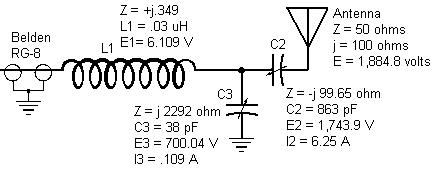Author: Frederick R. Vobbe, W8HDU
November 8, 2008
| Roll your own Coil for tuners and traps (Part 1) Author: Frederick R. Vobbe, W8HDU November 8, 2008 |
I remember making one coil that was 16" long, and consisted of 1/2" soft copper water line wound around a 20" form. This was used in an AM directional antenna array. I've also made coils from #14 solid copper wire, wound around drill bits or broom handles to form them to a shape. As the frequency increases, most of the time the size of the coil will get smaller. But this is not always the case. Careful calculation can optomize the circuit's efficiency and Q. There are several variables.
Usually you will need to calculate for one of two values, the number of turns, or the value in microhenrys. The formulas are as follows.
The coil can be compact with no space between the windings, or you can pull them apart. Typically when you pull them apart you get the best Q. In most HF work this can be .250", or 1/2 to 1 times the diameter of the wire you're using. When making coils be sure to consider the environment, and the rating. If the coil is inside equipment it may not need any protection. If the coil is outside, (perhaps in a tuning house), precaution should be taken for variations in temperture, physical fatigue, and safety. As far as the rating goes, some circuits can develop amazing amounts of currents and power. In an application such as an amplifier, or high power RF, stay away from small size wires. Coils can be fixed values or variable. A fixed value looks like this; While a variable can have one, or two tap points to allow for changing of values, like these;
A typical application for an RF coil would be in a tuner at the output of a transmission line at an antenna. Let's assume we have a transmitter in our shack, and were feeding a vertical out in the backyard. We'll assume that the frequency is 1,850 KHz, and have 1,000 watts of power. The transmitter output is 50-ohm with no reactive value (50+j0), and the antenna is 40 ohms and has a reactive component of 100. (40+j100). We're using Belden RG-8 50-ohm transmission line. We would need a tuner at the base of the antenna to match the 50 ohm line to the antenna. It would look something like this;  The one thing to note on this is the HIGH voltages on components C2 and C3. These voltages are enought to kill, so you need to take precautions for both arcing of these devices, as well as safety. For example, suppose your operating a contest and your child or pet wanders into the area where these devices are locate? Tapping a Coil
These clips come in a variety of different styles and sizes. The only precaution to take when you use clips, (besides the obvious mentioned above), is;
Now that you know how to design your own coil, how do you make one? to be continued Frederick R. Vobbe, W8HDU |
 |
© Copyright 2012 All Rights Reserved - W8HDU |